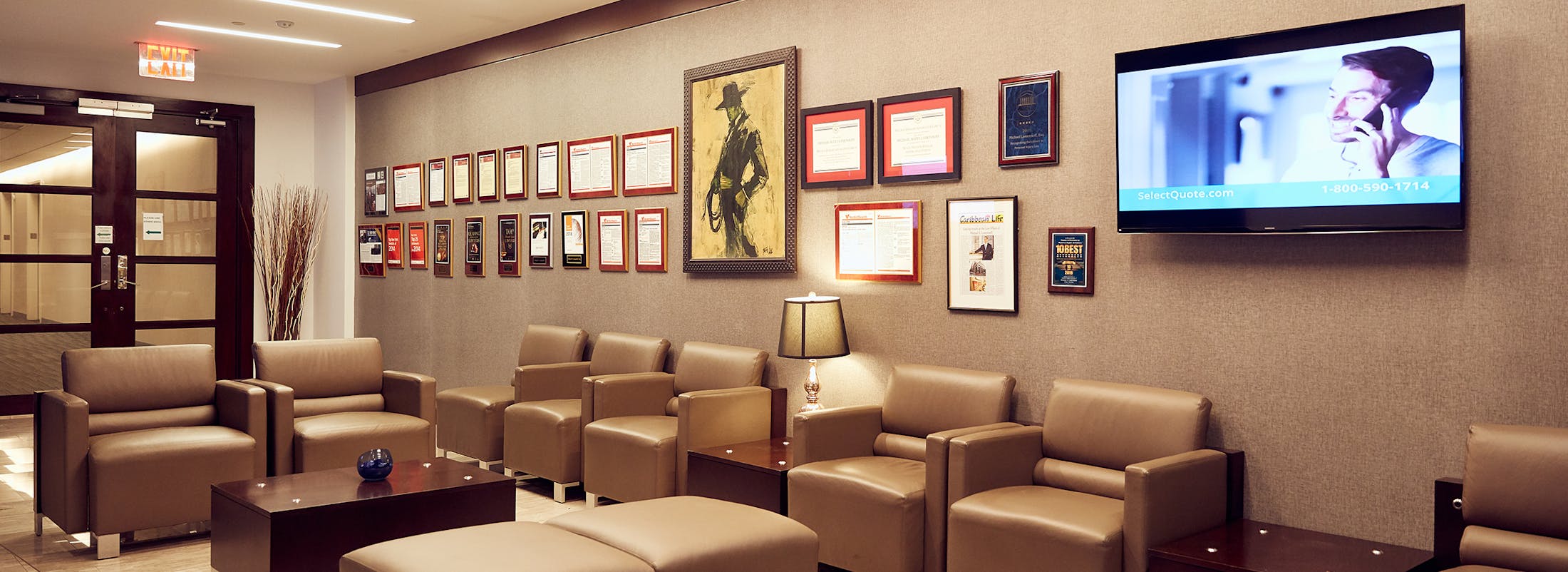Falling Objects On Construction Sites – How Dangerous Are They?
Construction workers know exactly how dangerous construction work is, and they know that falling objects are one of the most dangerous parts of the job.
Construction workers are injured by tools, equipment, and sometimes even by other construction workers falling from heights.
At construction sites around New York, could you be in danger?
If you’re injured by a falling object at a construction site, what is your recourse and how can a construction injury law firm help?
Of course, wherever the law of gravity applies, falling objects pose a danger.
According to OSHA (the Occupational Health and Safety Administration), more than 50,000 of us are injured every year at our places of work by falling objects.
In 2015, OSHA found more than 7,400 violations of fall protection safety regulations at construction sites across the United States.
The fact is that even now, in 2018, many contractors and construction firms, even in New York, still do not take the measures needed to reduce the number of injuries caused by falling objects at construction sites.
Those measures include the provision of personal fall protection systems, not only for workers, but also for their tools.
HOW DANGEROUS ARE FALLING OBJECTS?
Gravity can be an unexpectedly powerful force.
Math and physics easily demonstrate that an eight-pound wrench, for example, falling 200 feet will impact at a force of 2,833 pounds per square inch.
Falling objects can instantly become deadly objects anywhere, but particularly on construction sites.
In 2014, for example, a delivery driver was killed in Jersey City when a one-pound tape measure fell fifty floors at a construction site and impacted his skull.
Gary Anderson was delivering sheetrock to a construction site when the tape measure fell from the tool belt of a construction worker on the site’s fiftieth floor.
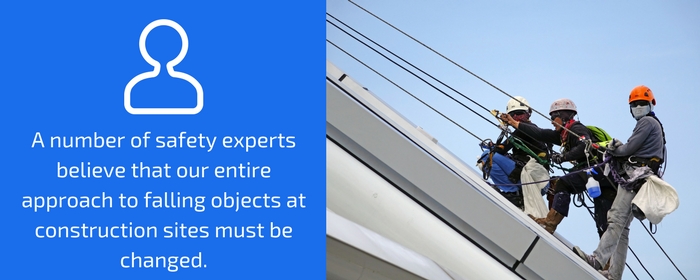
A number of safety experts believe that our entire approach to falling objects at construction sites must be changed.
We expect construction workers to be securely tied and to wear fall protection harnesses, but we do less to keep tools from falling.
Construction professionals simply assume that tools will fall, but it doesn’t have to be that way.
CAN INJURIES CAUSED BY FALLING OBJECTS BE PREVENTED?
In fact, most injuries caused by falling objects at construction sites are preventable injuries.
Some would say that the construction industry relies too heavily on toe boards, debris nets, and personal protective equipment to catch objects or at least reduce their damage.
Critics of current safety practices believe that rather than being focused on catching objects, we should instead actively pursue ways to prevent tools and other items from falling at construction sites.
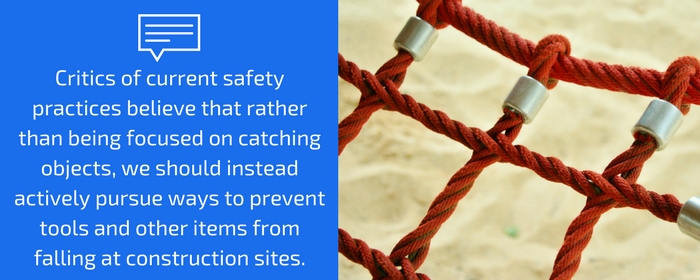
The thinking is that construction workers themselves wear harnesses – that is, they take a pro-active measure – whereas the use of debris nets to catch falling tools is a passive, after-the-fact measure.
The same proactive approach we use to keep people from falling should be used to keep tools and equipment from falling, because the goal is the same – avoiding injuries and fatalities.
Precisely what measures do the safety experts suggest to prevent tools from falling?
WHAT DO SAFETY EXPERTS RECOMMEND?
Lanyards and wristbands, self-vulcanizing tape, D-rings, and tool cinch attachments can often be used to secure a tool without impairing a worker’s ability to use the tool effectively.
Tools that weigh five pounds or more should be securely attached to a structure or to an approved anchor point – not to a person.
When attaching those tools, always check the load ratings: a tether that is load-rated for ten pounds will not secure a ten-pound tool if it is tied to an anchor point that is load-rated for five pounds.
OSHA requires all tools and materials to be secured in any work environment where workers might be imperiled by falling objects. OSHA also requires:
– warning signs and barricades for hazardous areas at a construction site
– the use of screens and toe boards on scaffolds and guardrails
– the use of catch platforms, canopies, and/or debris nets
New York construction accident attorney Joseph E. Gorczyca, with the Law Offices of Michael S. Lamonsoff, explains: “OSHA specifically requires ‘employers to provide protection for each employee exposed to falling object hazards.’ Falling object cases are some of the most common and deadly types of construction accidents. These endanger both the workers and the public-at-large.”
Additionally, according to attorney Gorczyca, “there are approximately 50,000 of these incidents every year.
According to EHS Today, a leading publication for occupational safety, these falling object cases result in ‘one injury caused by a dropped object every 10 minutes.'”
OSHA requires fall protection at heights of four feet in “general industry” workplaces, five feet for shipyards, and six feet at construction sites.
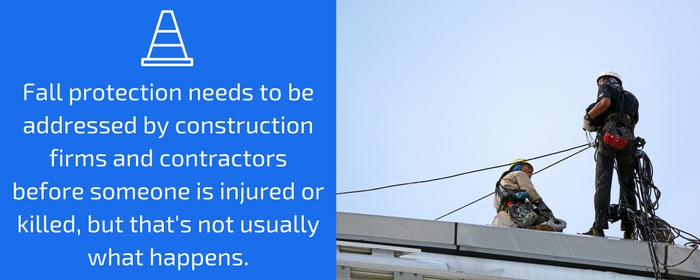
Fall protection needs to be addressed by construction firms and contractors before someone is injured or killed, but that’s not usually what happens.
Most employers only expand their safety programs and procedures – and make the necessary expenditures – after a serious incident takes place.
Choosing the appropriate fall protection equipment for a construction site is not an easy task, and it can’t be done hastily.
Construction companies, safety managers, and contractors must take the time to assess their safety needs and carefully review their options.
IF YOU’RE INJURED AT A CONSTRUCTION SITE, WHAT ARE YOUR RIGHTS?
If you sustain a job-related injury in New York City at a construction site, what is your recourse?
The specifics of every construction site accident are unique, so injured construction workers in the five boroughs will need the personalized and precise legal advice and insights that an experienced New York construction accident attorney can offer after reviewing the details of your case.
Many injured construction workers in New York City who seek reimbursement for their medical expenses and lost wages will be limited to workers’ compensation benefits.
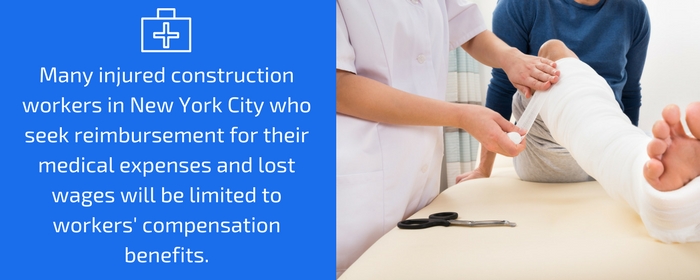
Workers’ comp is a “no-fault” insurance system that pays benefits to injured workers who are legally classified as “employees,” and those injured workers do not have to prove that anyone was at-fault or negligent.
In most cases, they merely have to prove that an injury was job-related.
IS WORKERS’ COMP AN INJURED CONSTRUCTION WORKER’S ONLY OPTION?
However, for other injured construction workers, workers’ compensation is not the sole option.
Construction workers usually deal not only with their employers and other employees but also with subcontractors, vendors, equipment and machinery operators, and delivery drivers.
When a construction worker is injured because of the negligence of any of those parties, he or she may qualify to file a personal injury claim against that party and/or that party’s employer.
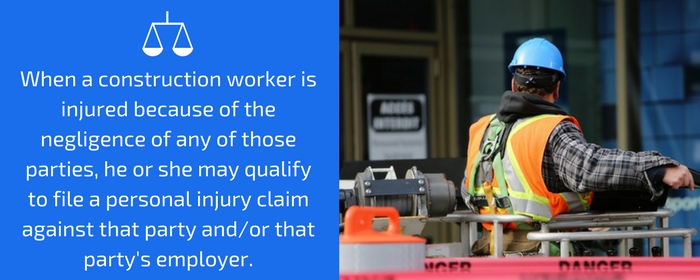
On a construction site, safety is everyone’s obligation.
If you are a construction worker, always report any condition or situation that might endanger yourself or others.
If you are injured on the job, discuss your legal rights and options with a skilled New York construction accident attorney.
Nothing is more important than your health and your future, and if you’ve been injured on the job because of someone else’s negligence, compensation is your right.

